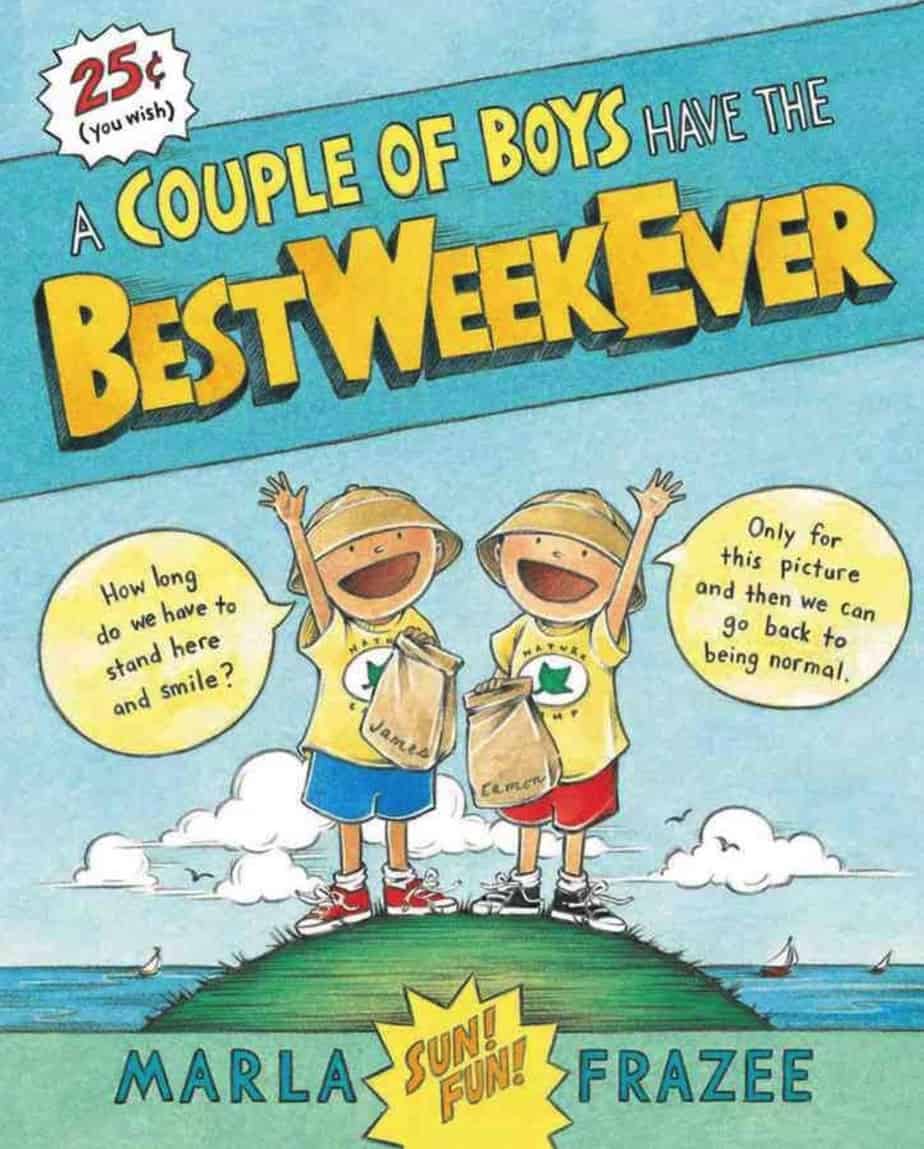A Couple Of Boys Have The Best Week Ever (2008), written and illustrated by Marla Frazee, was a Caldecott Honor book and garnered starred reviews from the big hitters. Today I’m taking a close look at what makes this book so good.
A PICTURE BOOK FOR PICTURE BOOK ENTHUSIASTS
It starts with the cover. This is a picture book for kids, but it’s also a picture book for people who have spent many years reading picture books, engaging the adult part of the brain. The joke on the cover is, “Who are these boys smiling at?” I have previously noted that when illustrators draw characters as if they’re posing for photographs, this is a form of direct address — sometimes accidental, I’m sure.
Smile, Baby! You’re On The Cover Of A Picture Book!
But here, Marla Frazee draws us in on the humour of this particular picture book convention (largely outdated now — you’ll find it on classic Little Golden Books). “How long do we have to stand here and smile?” asks one of the boys, simultaneously making the joke (to adults) and encouraging (child) readers to open the cover to get on with the adventure.
Let’s turn now to the back flap:
Marla Frazee based this book on real people and real events. Almost all of it is completely true. Except:
- Bill and Pam do not have a striped couch.
- James and Eamon do change their shorts occasionally.
- Bill’s vocabulary lessons don’t just happen when he’s driving.
But other than that, it is all true (sort of).
I love the observation about the shorts, because picture book illustrators make certain concessions for the sake of story, putting reality aside — one of those things is keeping the main character in the same clothing from beginning to end. Otherwise the young reader may not realise the character is the same person, especially when faces are drawn in generic style, as they are here, with dots for eyes and little else to distinguish between the two boys.
This is the kind of wry observation which appeals to an adult co-reader, achieving a genuinely dual audience. There’s an argument to be made that it’s impossible for children’s stories to be highly regarded unless they appeal to adults as well as to their ostensibly ‘main’ audience — kids. But there we have it. Children’s books are in fact ‘Everybody Books’, which is why they’re so hard to do well.
IRONIC DISTANCE BETWEEN TEXT AND ILLUSTRATION
A deadpan text narrates the events of the week, from the obligatory nature hikes and sleeping on an inflatable mattress downstairs to Bill’s well-meaning attempts to engage them in wildlife study and Pam’s great cooking.
Kirkus
What does Kirkus mean when they say ‘deadpan’? How do picture book creators achieve deadpan?
I believe Kirkus is referring to what Maria Nikolajeva and Carole Scott have called ‘ironic distance’. Later Kirkus uses the word ‘counterpoint’. Publisher’s Weekly calls it ‘contradiction’.
The standout example of this concept is seen in Rosie’s Walk, in which the pictures tell a completely different story from the text. For any given illustration/text combo, we can plot it somewhere on the ‘ironic distance continuum’. In this particular book, the deadpan humour is achieved by doing the ironic inverse of what Pat Hutchins did. In Rosie’s Walk the main text is staid while the illustrations contain life and death excitement. In A Couple Of Boys Have The Best Week Ever, the text often promises excitement while the boys sit around and do basically nothing. The point is, holidays promise much but sometimes deliver little other than quiet contemplation and relaxation.
EXAMPLES OF IRONIC DISTANCE
Text: Eamon thought this chat was fascinating.
Illustration: Eamon, a middle-childhood aged boy, sits on the sofa between two elderly people. The look on his face suggests he is very uncomfortable. His posture suggests he wants to get off the sofa and do something else. It is clear he does not find the chat about penguins fascinating.
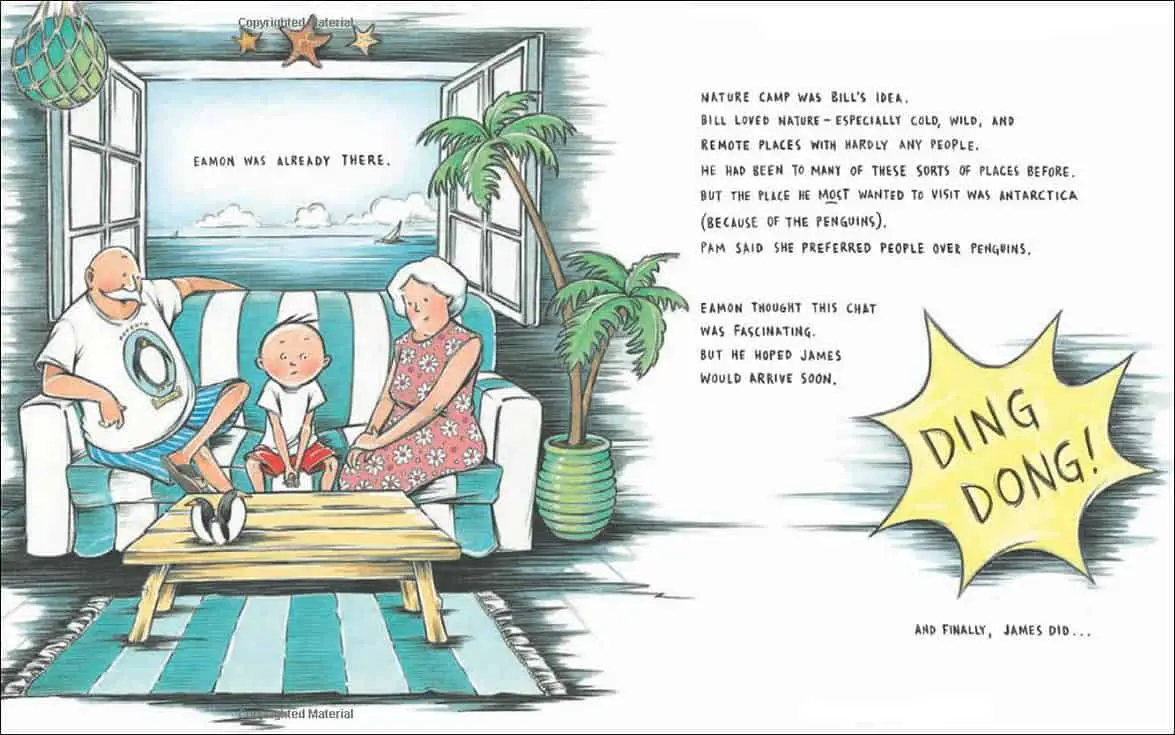
Text: And finally James did [arrive] with just a couple of his belongings.
Illustration: James has arrived with a hyperbolic, ridiculous amount of luggage, overflowing from cardboard boxes.
Text: He had never been away from home for an entire week, so he was very sad when his mother drove away.
Illustration: James has a big, confident grin on his face and the speech bubble suggests he shouts ‘Bye!’ enthusiastically. He is not sad at all.
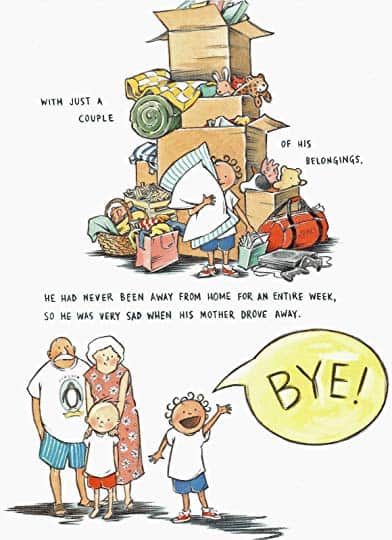
As is evident from these first examples, the ironic distance is to do with emotion. Marla Frazee is expert at conveying emotion via facial expression and body language. A less experienced illustrator would’ve had a hard time pulling this off.
I’d like to note, too, that picture book writers are often advised to ‘leave out anything that can be conveyed by the illustrator’. A sentence like ‘He was very sad’ is often given as an example of exactly the sort of thing that should be left to the illustrator. What’s often left out of these discussions is that sometimes the illustration says the opposite. Writers are advised to add illustration notes only if there is a very big ironic distance between illustration and text. This is where an author/illustrator is at a massive advantage — Marla Frazee is able to milk the entire continuum of ironic distance because she’s doing both. I’m constantly amazed at how well illustrators and writers work together to create excellent picture books when they don’t sit down at the initial stages to work things out together, but author illustrators equally adept in both (rare) certainly have this extra edge.
The comic book format of A Couple Of Boys Have The Best Week Ever is a good choice to convey the ironic distance between adventure and relaxation, because comic books are so heavily associated with super heroes, and super heroes never sit around — they’re always gearing up for something heroic, and then doing it.
THEMES
My own child was born in 2008, the year this was published, and I think the storyline has only become more relevant since then. Once kids are dragged away from their devices it takes a while for them to re-engage the kind of imaginative thinking which results in penguins made from gathered beach items. These boys are taken on a journey from the modern world into the world of their own imaginations, symbolically transporting them back to a more simple time.
This is the exact kind of nostalgia which appeals to the adult audience, and confirms my view that this book will be understood on a different level by adults. (My premise is that nostalgia is the one emotion young children cannot share with adults.)
THE GRANDPARENT ARCHETYPE IN CHILDREN’S BOOKS
This story also subverts some expectations adults will have about picture books. We’re used to child-grandparent combos in which the grandparents have regressed back to childhood and enjoy fantastic adventures at the level of a child. Think Grandpa Jo from Charlie and the Chocolate Factory, and all the picture books featuring dancing grannies who have time for their grandchild even though the parents are too busy to notice the magic around them.
This books is not like that. This book is more akin to my own reality. Grandparents have time for grandchildren and go out of their way to create fun experiences, but the grandchildren remain wholly unappreciative. Because let’s face it, there has never been a bigger generation gap than that which exists between today’s grandparents and their grandchildren. Technology is the clear reason.
STORY STRUCTURE OF A COUPLE OF BOYS HAVE THE BEST WEEK EVER
So what are children to make of this picture book? If we take away the parts they won’t yet identify with, is there enough left in the story for them? The answer is yes, but this is a picture book for a slightly older audience than the 3-4 year old set — the child reader will have to understand irony. This typically happens around age 8. So I might introduce this story to 7 year olds and up, with plenty of conversation from the adult co-reader.
SHORTCOMING
There’s no clear ‘main character’ because this is the story of a ‘generation gap’, in which the kids and older people are equally important. But young readers will naturally identify with the boys, so let’s go with them.
James and Eamon are a realistic admixture of excited and apathetic. Now that I think about it, this is a very rare thing in picture books. They’re excited to be with each other at their grandparents’ house, but together they slip into this snarky, underwhelmed attitude which bonds them to one another rather than to the older man who is ferrying them around.
“I thought you are supposed to walk on a hike,” one says to the other in the back seat of the grandpa’s car. “Yeah, not stand and look at some flower for an hour,” the other snarkily replies. Significantly, they sit very close together while the grandfather figure remains removed, in the front seat of the car and driving.
So, these boys have a clear moral shortcoming — they are failing to appreciate all that is right there for them to enjoy. Would the child reader have the same response as me, who is used to being an unappreciated chauffeur? I doubt it.
Their psychological shortcoming is that they have forgotten how to have a full spectrum of fun. The zombie-eyed illustration of the boys staring into a television is a commentary on how ‘young people these days only notice the world around them when it’s happening through a screen’. This is clearly from an adult’s point of view — an older generation commenting upon a younger generation.
There’s another layer of humour in the zombie-eyed scene — Pam has given the boys coffee ice-cream — massive icebergs of it. I recently made the mistake of buying ‘Coffee Intense’ flavoured ice cream from Woolworths and inadvertently lay awake all night after eating it — my previously sampled coffee ice cream from Aldi must have basically no caffeine in it.
DESIRE
The boys want to have fun on holiday, but they don’t know how to have the right kind of fun. Frazee’s illustrations mimic real life when she shows the boys having fun one moment, bored and zoned out the next. That’s exactly what modern kids are typically like. Moreover, the boys are rough housing with each other when the grandfather figure has unrolled a large map for them to appreciate. They are having fun, but it’s the sort of fun which can’t be contrived.
OPPONENT
The grandparents’ idea of fun activities is at odds with that which James and Eamon find genuinely diverting, so Young vs Old make natural Opposition.
PLAN
The boys ostensibly plan nothing — in naturalistic stories, kids don’t always make plans. They have to go along with adults’ plans. However, they do make their own mini-plans, to have fun in the moment. Their running gag is that they do everything in the same way. This constitutes a plan of sorts, kiddie version.
Finally they decide to do as they were expected to do all along — go outside of their own volition.
BIG STRUGGLE
The boys have been battling with the older people all week, not in any traditional sense, but the older generation has set ideas about how boys should spend time at ‘Nature Camp’.
This long-running Battle ends after the old people have exhausted themselves trying, and fall asleep snoring on the sofa. This is when the ‘winners’ emerge victorious — the boys go outside and look at their natural surroundings for the first time.
ANAGNORISIS
And it turned out to be the very best part of the best week ever.
This is a rare example of a story in which the main characters as well as the ‘opponents’ have both come out equally victorious. The boys have learned to appreciate the natural world around them, just as the older folks have been aiming for all along. However, they couldn’t be finagled into appreciating it. It was only after the old people removed themselves that the boys were afforded time to get bored, and inspired.
The adult reader learns from this story that kids don’t appreciate things in the way we hope, though they will still be appreciating our efforts in their own way. We’ll have an easier time of child care if we just let kids get bored sometimes.
The genius here is not that the boys finally get outside in the end; it’s that their joy in being together is celebrated equally whether they’re annihilating each other in a video game or building a replica of Antarctica on Bill and Pam’s dock. As respectful of kid sensibilities and priorities as it’s possible for an adult to achieve.
Kirkus
NEW SITUATION
The reader has seen it was boredom itself that led to the boys’ true appreciation of nature. They have now made their own fun using very low-tech items and we can extrapolate that they have learned the skill of playing outside in nature.
I doubt it’ll endure when they’re back in their regular world of scheduled activities and computer games, but one day, if these boys become parents, they’ll probably teach their own kids to make penguins out of seashells.
COMPARE AND CONTRAST
A Couple Of Boys Have The Best Week Ever reminds me of an older book from the early 1980s, Three Days On A River In A Red Canoe by Vera B. Williams.
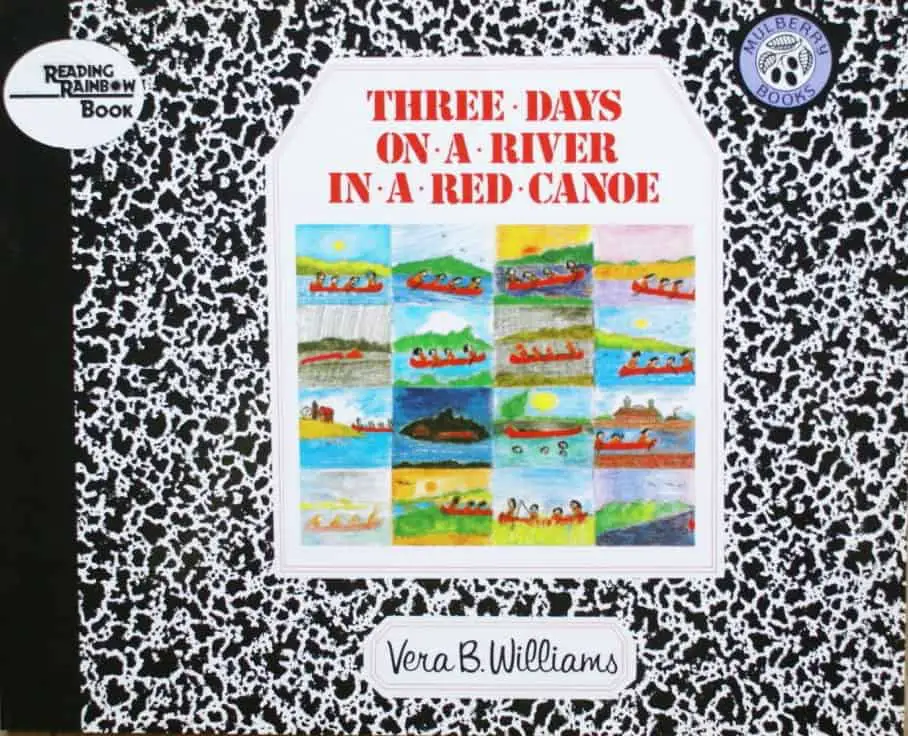
Follow the red canoe from page to page as it journeys down river carrying the family on a camping tour. It’s the next best thing to paddling it yourself.
MARKETING COPY
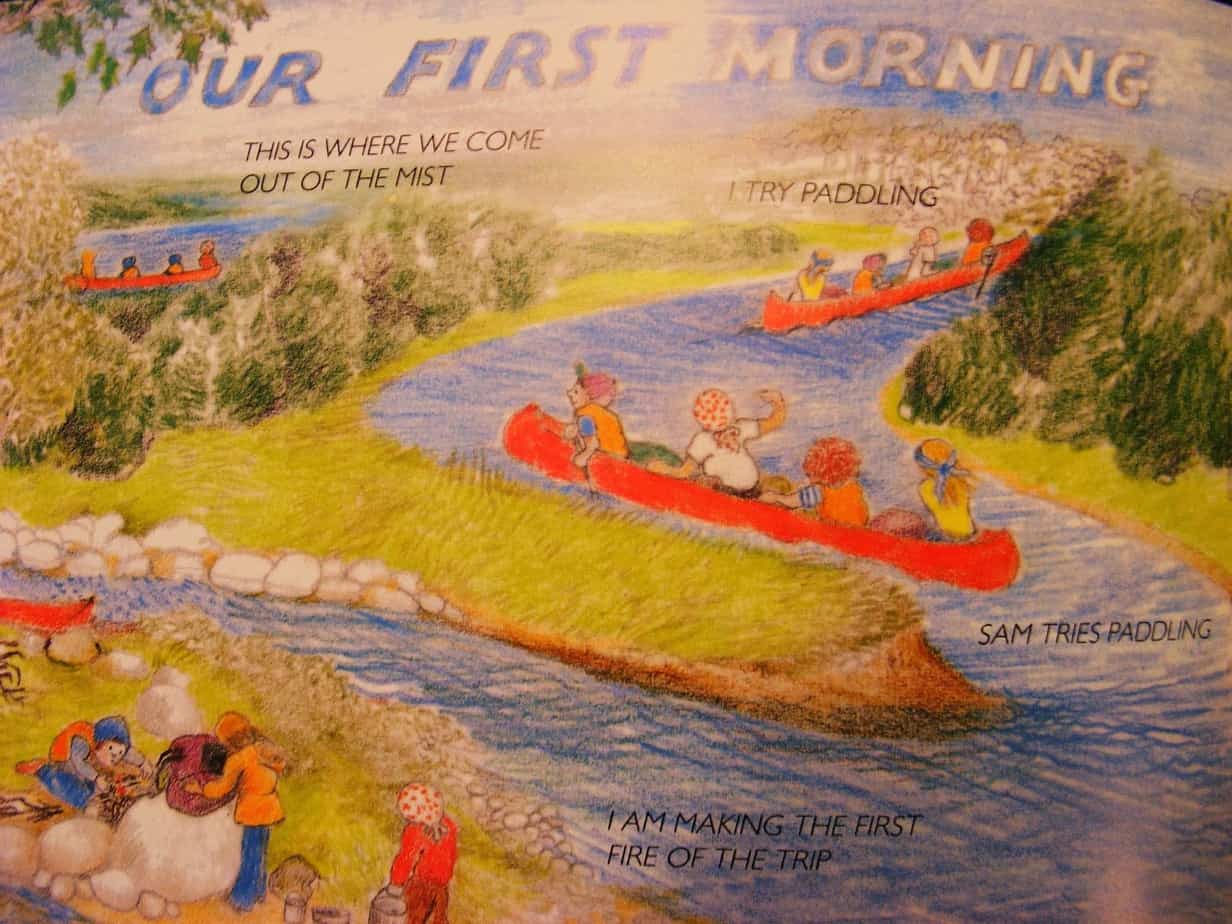
In Williams’ story, a family go on a canoe down a river — what it says on the tin. The story takes young readers through the entire process, from planning and packing to coming home and feeding the caught fish to the cat.
Three Days On A River In A Red Canoe is a good example of a narrative in which the main opponent is ‘nature’ rather than other characters: First it rains, thenthere is a gale, then the canoe almost overturns in the current of the river.
I’m reminded of Frazee’s story because the in both stories, the artwork is simple enough to let a young reader think they can produce something similar. I was recently listening to a picture book illustrator saying that she includes more naively drawn illustrations in each spread with the specific purpose of inviting the reader to create their own.
Frazee’s story is a picture book/comic book blend in its layout; Williams’ story is a picture book/informational text blend, and even ends with a non-fiction section on rivers.
Of course, both are about holidays, and the titles are similarly structured.
FURTHER READING
Ilan Kelman’s book Antarcticness: Inspirations and Imaginaries (UCL Press, 2022) joins disciplines, communication approaches, and ideas to explore meanings and depictions of Antarctica. Personal and professional words in poetry and prose, plus images, present and represent Antarctica, as presumed and as imagined, alongside what is experienced around the continent and by those watching from afar. These understandings explain how the Antarctic is viewed and managed while identifying aspects that should be more prominent in policy and practice.
The authors and artists place Antarctica, and the perceptions and knowledge through Antarcticness, within inspirations and imaginations, without losing sight of the multiple interests pushing the continent’s governance as it goes through rapid political and environmental changes. Given the diversity and disparity of the influences and changes, the book’s contributions connect to provide a more coherent and encompassing perspective of how society views Antarctica, scientifically and artistically, and what the continent provides and could provide politically, culturally, and environmentally.
New Books Network
